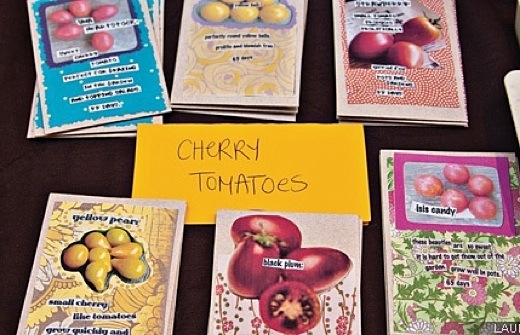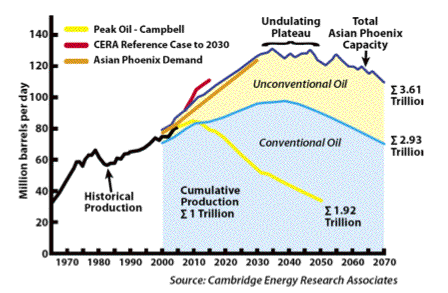By Pamela Cuthbert on 22 October 2009 in Macleans -
http://www2.macleans.ca/2009/10/22/farmers-markets-for-seed-savers

Image above: Table at seed exchange market. Photo by Laura Berman
It’s for the birds, right? Saving and spreading seed is what Mother Nature does while we’re not looking. So why is there an increasingly popular grassroots movement of seed swappers, most of them new, urban growers, who are taking matters into their own hands? It’s the latest chapter in the local foods craze that meticulously traces sources: “field to fork” has now become “seed to spoon.”
“There’s a garden revolution going on,” says Vandana Shiva, the world’s leading seed-saving activist, on the phone from her home in Dehra Dun in the Himalayan state of Uttarakhand. Shiva, who earned her Ph.D. in physics from the University of Western Ontario and who is making a rare appearance at the University of Toronto this month, ranks as the grand protector of small-scale farmers and gardeners. In 1987, the pre-eminent powerhouse, author and environmentalist founded the Navdanya association in India that supports farmers with seed banks, educational programs and what she calls the “right to seed.”
Says Shiva, with unblinking conviction, “For every urban gardener who keeps exchanging seed, that’s the highest duty and governments will have to bend to this.” Her organization has also taken on global seed-patent fights. In the past 25 years, commercial seeds for industrial farming have steadily come under copyright law. The patents, now a multi-billion-dollar business, are owned by multinationals such as Bayer and Monsanto.
Navdanya has stopped three seed patents to date. The small-scale seed-sharers aren’t generally dealing in patented goods—a lot of that is genetically modified, which they tend to avoid—but these efforts, tied in with improved access for urban agriculture at schools and community gardens, are part of an increasingly vocal protest against the ownership of seeds. Ian Aley is with FoodShare, a non-profit focused on hunger and food issues in Toronto.
“The reason we do seed saving and include it in our urban agriculture program,” he says, “is because of a broader issue: having autonomy and having control over our own food sources.” These urban farmers are also proving effective guardians of biodiversity, whether that means saving rare plums or out-of-style varieties like yellow corn. The trend is nationwide: “Seedy Saturdays” began in Vancouver 20 years ago as an annual, small-scale get-together run by the grassroots organization Seeds of Diversity Canada. The event is much like a farmers’ market, but the goods are delivered in small packets, not in bushels or baskets. It’s grown to include places like Winnipeg, Saskatoon, Montreal, and Victoria.
In Toronto this spring, attendees “doubled to more than 2,000,” says Rhonda Teitel-Payne, one of the event’s organizers. Asked if these small-scale projects make a difference, Shiva says: “They’re the only thing that can make a difference.” For others in the field, there’s a different kind of reward: not only the pleasure of producing foods for your family table, but, given that many community gardens operate in urban areas inhabited by new immigrant families, the chance to taste foods remembered from one’s homeland or brought from elsewhere.
Len Miranda is the volunteer coordinator of Lorna’s One Love community garden in Scarborough, Ont., which, divided into 32 tiny plots, overlooks a rail line and the concrete apartment block where he lives. Miranda cites two discoveries this season: a squash from his native Jamaica that he’s surprised can thrive in these cool climes, plus an Indian variety of amaranth.
The leafy green, commonly used in the popular stew called callaloo, grows wild as a weed locally, but this variety “produces six times the normal amount one of ours does. So we’ll put some of that seed aside. It could add up to a lot of food.” New alliances are also being forged.
The Toronto-based 14-year-old Afri-Can Food Basket is working to save seeds with a department of the University of Guelph, an institution associated with commercial agriculture. Besides this project, others are springing up: there are seed-saver educators, workshops, even an online world seed map for keeners who want to learn about the origins of seeds. Shiva puts it simply: “Everyone’s swapping seed. It’s our sacred duty on earth.”
There’s one more reason to do it, Shiva says: “Taste. It’s a long-honoured tradition: we save seed for taste, nutrition and health instead of industrial breeds that are made for profit and for yield.”
See also:
Ea O Ka Aina: Kauai Seed & Plant Exchange 10/4/09





 Most people don’t realize chickens can fly. If you don’t provide them a home to sleep in at night they will often fly up into the safety of nearby trees. These trees may or may not be on your property. This could cause conflict with neighbors and is another reason to provide your chickens with a home. You can clip their wings to keep them grounded. This is accomplished by spreading one wing and cutting off the ends of the feathers.
Most people don’t realize chickens can fly. If you don’t provide them a home to sleep in at night they will often fly up into the safety of nearby trees. These trees may or may not be on your property. This could cause conflict with neighbors and is another reason to provide your chickens with a home. You can clip their wings to keep them grounded. This is accomplished by spreading one wing and cutting off the ends of the feathers.









 Worms. You can use worms to eat your leftover food and quickly turn it into worm castings, a wonderful compost for your garden. The practice is called
Worms. You can use worms to eat your leftover food and quickly turn it into worm castings, a wonderful compost for your garden. The practice is called 



